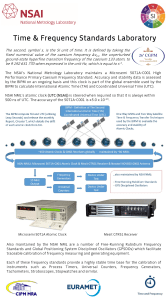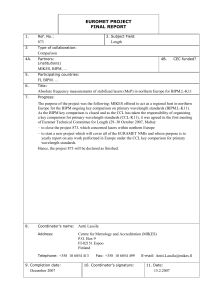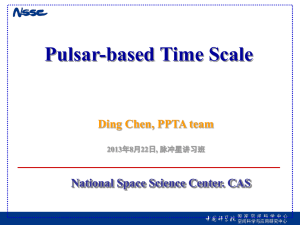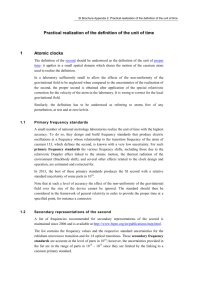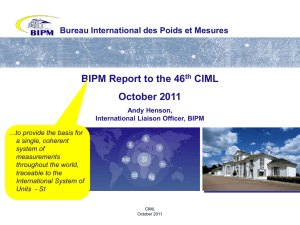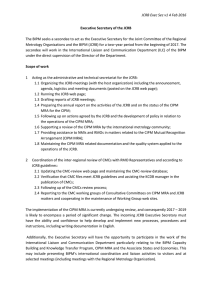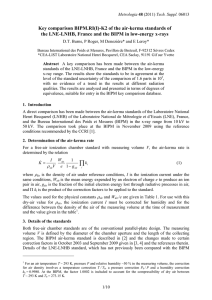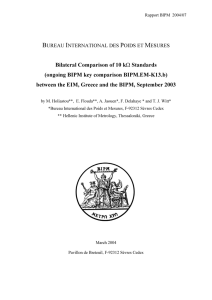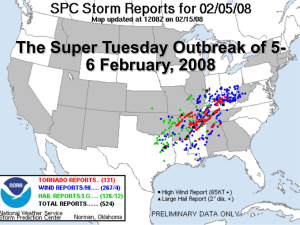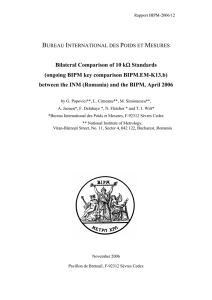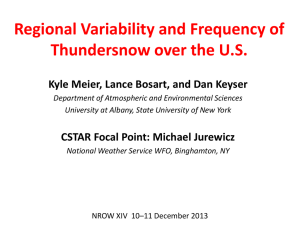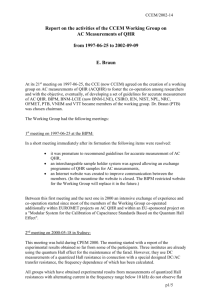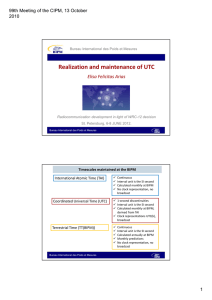Thesis title
advertisement
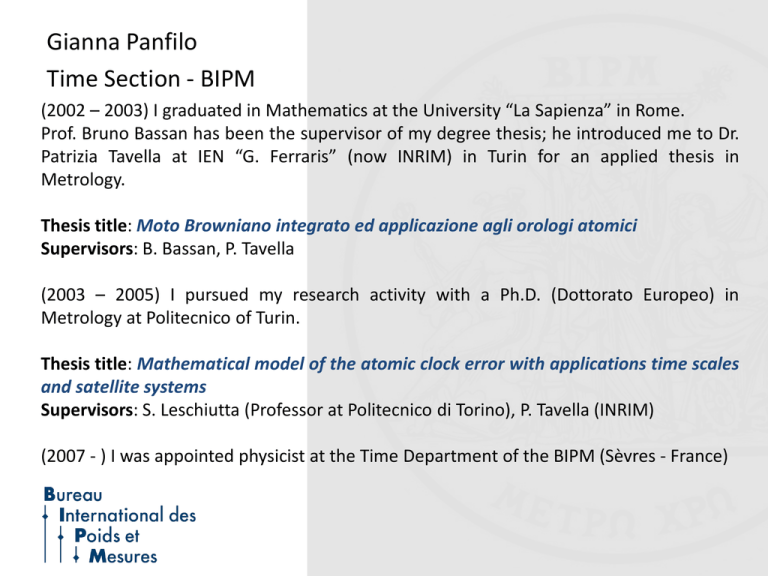
Gianna Panfilo Time Section - BIPM (2002 – 2003) I graduated in Mathematics at the University “La Sapienza” in Rome. Prof. Bruno Bassan has been the supervisor of my degree thesis; he introduced me to Dr. Patrizia Tavella at IEN “G. Ferraris” (now INRIM) in Turin for an applied thesis in Metrology. Thesis title: Moto Browniano integrato ed applicazione agli orologi atomici Supervisors: B. Bassan, P. Tavella (2003 – 2005) I pursued my research activity with a Ph.D. (Dottorato Europeo) in Metrology at Politecnico of Turin. Thesis title: Mathematical model of the atomic clock error with applications time scales and satellite systems Supervisors: S. Leschiutta (Professor at Politecnico di Torino), P. Tavella (INRIM) (2007 - ) I was appointed physicist at the Time Department of the BIPM (Sèvres - France) The BIPM The BIPM is an intergovernmental organization acting on matters related to measurement science and measurement standards. The mission of the BIPM is to ensure and promote the global comparability of measurements, including providing a coherent international system of units for: • Scientific discovery and innovation, • Industrial manufacturing and international trade, • Sustaining the quality of life and the global environment. 2 The BIPM Time Departement research products The realization and dissemination of the international time scales is the responsibility of the Time Department of the BIPM. International Atomic Time (TAI) is a weighted mean time scale, with the contribution of hundreds of atomic clocks hosted in many laboratories all over the world. The scale interval is a kept as close as possible to the SI second, as provided by primary frequency standards. Coordinated Universal Time (UTC) is derived from TAI, to provide a reference scale in step with the irregular rotation of the earth. UTCr, a rapid realization of UTC Local realizations of UTC, called UTC(k), often available and disseminated in real time, exist at time laboratories contributing to TAI. For Italy: - UTC(IT) at INRIM in Turin (the national metrological institute) - UTC(CAO) at Osservatorio astronomico di Cagliari 3 UTC, TAI and UTCr UTC and TAI are calculated: 1. 76 time laboratories and observatories 2. 55 different countries 3. About 450 atomic clocks 4. About 15 primary frequency standards 5. 1 Secondary standard 1. 2. UTCr is calculated: 44 time laboratories and observatories About 300 atomic clocks 4 How does the Mathematics is used? Mathematical tools for time metrology: - Stochastic Processes to model atomic clock behaviour (Brownian Motion, Integrated Brownian Motion etc.) - Statistical Tools used to optimize all the available data (Kalman Filter, Wavelet etc. ) www.bipm.org http://www.bipm.org/en/bipm-services/timescales/time-ftp.html 5 TAI algorithm basics Weighting algorithm Prediction algorithm N EAL t wi hi t hit i 1 N N wi xi t wi hit i 1 i 1 x t x t x t j i, j i N x j t EAL h j wi hit xi , j t i 1 The main work at this stage is the study of weighting and prediction algorithms to improve the performance (in some physical meaning) of UTC. 6 The Frequency of EAL f(EAL)-f(PFS) 68.5 NIST-F1 PTB-CSF1 PTB-CSF2 SYRTE-FO1 SYRTE-FO2 SYRTE-FOM IT-CSF1 NPL-CsF1 NPL-CsF2 NICT-CsF1 NMIJ-F1 NIST-F2 IT-CSF2 NIM-NIM5 SU-FO2 SYRTE-FORb Normalized Frequency 10 -14 68 67.5 67 66.5 66 65.5 65 64.5 54000 55000 56000 57000 MJD 7 In the acknowledgements of my PhD thesys I wrote: I believe that this work could not even start without the constant support and encouragement provided by Bruno Bassan. Bruno Bassan passed during 2004, leaving a terrible void. Ciao Professore Reflecting on my present life, I think this «acknowledgement» still holds its prominence today. www.bipm.org
